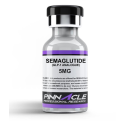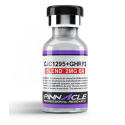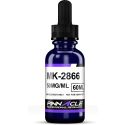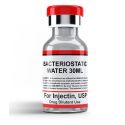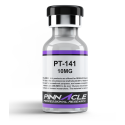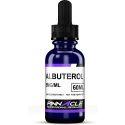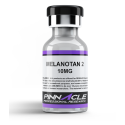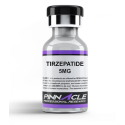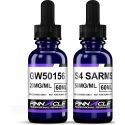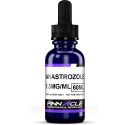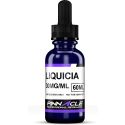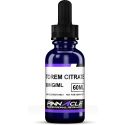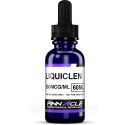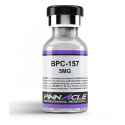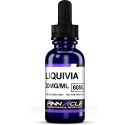How Much Water is Needed to Mix Peptides Properly?
This website's contents, articles and product information are all provided purely for educational and informational purposes. The products that are offered on this platform are only meant to be used in in vitro research. The word "in vitro," which comes from the Latin "in glass," describes research that is done outside of a living creature. It is important to remember that these products are not pharmaceuticals or medicines, and the FDA has not approved them for use in the diagnosis, treatment, or prevention of any illnesses or disorders. It is legally forbidden for these goods to be ingested by humans or animals.
Peptides are short chains of amino acids that are naturally produced and used by the human body. They play an important role in many bodily functions including building muscle, burning fat, improving cognition, enhancing mood, increasing injury recovery, and more.
In recent years, synthetic versions of certain peptides have become popular as supplements to amplify these benefits. Some of the most common peptide supplements include:
- Growth hormone peptides like MOD GRF 1-29, GHRP-2, GHRP-6, CJC-1295, and Ipamorelin to boost growth hormone levels for anti-aging, muscle building, and fat loss effects.
- Cognitive and mood peptides like Semax, Selank, Cerebrolysin, and BPC-157 that can improve focus, learning, memory, and feelings of wellbeing.
- Recovery peptides like BPC-157, TB-500, and Thymosin Beta 4 to help accelerate healing of injuries.
With the variety of peptides for sale from online suppliers, it's important to research peptides thoroughly and purchase them from a trusted peptides supplier. Getting the dosage, mixing, and storage right is key to experiencing the unique benefits they offer.
Why Proper Mixing is Critical
When reconstituting and mixing peptides, following the proper protocol is essential for the peptides to remain stable and work effectively.
Peptides are delicate compounds that can degrade or become less potent if not handled correctly. Exposure to heat, light, moisture, or improper solvents can cause them to deteriorate.
Using the incorrect amount of water when reconstituting peptide powder can also impact stability. Too much water may dilute the peptide, making it less potent, while too little water can make it difficult to dissolve properly or lead to aggregation.
Proper mixing with sterile water or bacteriostatic (bac) water is crucial for:
- Achieving full solubility: The peptide powder must fully dissolve to allow for accurate dosing and maximum absorption [1].
- Preventing degradation: Keeping peptides in solution protects them from breaking down prematurely.
- Safe administration: Reconstituted peptides can be injected through insulin syringes. Proper mixing eliminates particulates.
- Absorption Optimizing concentration for injection allows the peptide to be efficiently absorbed into circulation.
Following your peptide supplier's specific reconstitution guidelines for the amount of water to use is imperative. Their instructions are tailored to their peptide types and purity levels.
Adhering to precise reconstitution protocols will ensure you experience the full stable potency of peptides and their unique benefits.
Key Factors That Influence Water Needed
There are several key factors that impact how much water is needed when mixing peptides:
The specific type of peptide - Some peptides are more soluble than others and require different water amounts to fully dissolve the powder. For example, BPC-157 can be reconstituted with less water compared to many other peptides [2].
Purity and concentration - The purity and concentration per mg of the peptide powder affects how much water is needed for proper reconstitution. Higher purity, more concentrated peptide requires less solvent [3].
Bacteriostatic (bac) water vs. sterile water - Bac water contains the preservative benzyl alcohol to prevent bacterial growth. Since it takes up volume, slightly less bac water may be needed for dissolving [4].
Intended dosage and volume - The final volume for injecting determines water amounts. Aim for practical volumes between 0.5-2mL to withdraw the intended dosage conveniently [5].
Typical Water Amounts by Peptide Type
The amount of water generally needed to reconstitute peptides depends on the type of peptide:
Growth hormone peptides:
- MOD GRF 1-29: 2-4mL water per vial
- GHRP-2: 2-3mL water per vial
- GHRP-6: 2-3mL water per vial
- CJC-1295: 2-4mL water per vial
- Ipamorelin: 2-4mL water per vial
Muscle building peptides:
- Follistatin: 2-4mL water per vial
- Myostatin: 2-4mL water per vial
- GHRP-6: 2-3mL water per vial
Cognitive and mood peptides:
- Semax: 2-5mL water per vial
- Selank: 2-4mL water per vial
- Cerebrolysin: 2-4mL water per vial
- BPC-157: 0.5-2mL water per vial
Healing and recovery peptides:
- BPC-157: 0.5-2mL water per vial
- TB-500: 1-2mL water per vial
- Thymosin Beta 4: 2-4mL water per vial
These ranges provide general guidelines but suppliers will provide specific instructions tailored to the purity and dosage of their peptide products.
Supplier Mixing Instructions
While there are general guidelines for water amounts for mixing different peptide types, it is essential to follow your specific peptide supplier’s reconstitution instructions.
Recommended water amounts can vary between peptide suppliers based on:
- Purity of the peptide powder
- Concentration per mg
- Desired dosage amounts
- Recommended injection volume
- Type of diluent used (bac water vs. sterile water)
For example, Pinnacle Peptides provides the following reconstitution recommendations for some of their peptide products:
- CJC-1295 DAC - Use 2-3mL bac water per 2mg vial
- GHRP-2 - Use 2-3mL bac water per 5mg vial
- BPC-157 - Use 1-2mL bac water per 5mg vial
- Melanotan II - Use 2-3mL bac water per 10mg vial
Their guidelines are specific to the purity, concentration, and recommended dosing for the peptides they sell.
Whenever researching peptides to purchase from a supplier like Pinnacle Peptides, be sure to fully read and follow their guidelines for reconstitution. Their instructions for the amount of water ensure optimal stability, dosing accuracy, and effectiveness when mixing peptides.
How to Reconstitute Peptides Safely
Once you know the proper amount of water to use, here is a step-by-step guide to reconstituting your peptides safely:
- Gather your supplies - peptide vial, insulin syringes, diluent (bac water or sterile water), alcohol swabs.
- Clean your work surface with an alcohol swab. Wash your hands thoroughly.
- Swab the tops of both the peptide and diluent vials with alcohol to sanitize them.
- Carefully open the sealed peptide vial, trying not to touch the rubber stopper.
- Open the diluent vial and use your syringe to draw up the amount of water specified in the supplier's instructions.
- Inject the water from the syringe into the peptide vial.
- Gently roll the peptide vial between your fingers until the powder fully dissolves. Do not shake vigorously.
- If needed, use the syringe to transfer the solution back and forth between the vials to ensure full mixing.
- Store reconstituted peptides in the refrigerator and use within the time frame specified by your supplier.
- Peptides are now ready for measuring doses and injecting. Discard any unused portion after the specified days.
Always follow sterile procedures and your supplier's guidelines closely when reconstituting peptides. Take care to properly calculate water amounts, mix, store, and inject to get the most benefits from your peptide therapy. Here is a new section I have added to the article, incorporating the keyword naturally:
Choosing a Reputable Peptide Supplier
With the growth in popularity of therapeutic peptides, there are many options to purchase peptides online. However, not all suppliers are created equal when it comes to the quality, purity, and safety of their products.
It is important to do thorough research when choosing a peptide supplier to ensure you are getting the highest quality compounds. Here are some tips:
- Look for suppliers that provide third-party purity testing certificates for their peptides. This helps verify the quality and concentration.
- Read through independent lab reviews that test suppliers for purity and contaminants. Look for reviewers that test multiple suppliers.
- Examine customer reviews and forum discussions detailing experiences purchasing from the supplier. Look for consistently positive feedback.
- Avoid peptides sources that seem suspiciously cheap compared to average prices. This can indicate poor quality.
- Choose a supplier located domestically over international if possible for quicker and more reliable shipping.
- Look for a satisfaction guarantee and certificates of analysis (COAs) for each batch. Reputable suppliers stand behind their products.
- Consider suppliers like Pinnacle Peptides that offer a wide variety of peptides for research purposes and have built a trusted reputation in the marketplace.
Taking the time to thoroughly research peptide suppliers can help give you confidence you are purchasing high-quality peptides for your needs. Investing in purity helps maximize the benefits and return on your peptide therapy.
Frequently Asked Questions
How much bacteriostatic water should I use to mix 5mg of BPC-157?
For a 5mg BPC-157 vial, use 1-2mL of bacteriostatic water according to most supplier guidelines. Purity can vary so follow their specific amount.
Can I use sterile water instead of bac water to reconstitute peptides?
Yes, sterile water works but has a shorter shelf life. Bac water contains benzyl alcohol to prevent bacterial growth.
What determines the water amount needed?
The peptide type, purity level, desired injection volume, and choice of bacteriostatic or sterile water all impact the water amount.
Is more or less water better when mixing peptides?
Too much over-dilutes, decreasing potency. Too little prevents full dissolution. Follow recommended water amounts closely.
How should I store reconstituted peptides?
Store mixed peptides refrigerated at 2-8°C for the timeframe specified by your chosen peptide supplier to maintain stability.
Can I reuse reconstituted peptides after injecting a dose?
Best practice is to discard after the specified number of days even if some remains. Peptide stability declines after initial reconstitution. Do not reuse after injecting.
What is the best way to mix the peptide powder and water?
Roll the vial gently between your fingers until the powder dissolves. Do not shake vigorously. Swirl gently if needed. Invert the vial periodically to help dissolve.
Should I use room temperature or cold water to reconstitute peptides?
Most suppliers recommend using water at room temperature to reconstitute peptides. Cold water can slow dissolution.
What size insulin syringes should I use to inject peptides?
1mL syringes are commonly used. Sizes between 0.5mL to 1mL work well for measuring doses and injecting peptides conveniently.
Can I mix different peptides into the same syringe to inject together?
It is not recommended. Each peptide requires specific water amounts to properly dissolve based on the concentration. Mixing can impact stability.
Conclusion
Properly reconstituting peptides is a critical step to maintain their stability and effectiveness. Following your peptide supplier’s instructions on how much water to use when mixing peptide powder is imperative.
The amount of water needed can vary based on the type of peptide, its purity level, desired dosage volume, and choice of diluent. Growth hormone peptides, cognitive peptides, and muscle building peptides all require different water amounts for optimal reconstitution.
Once you know the proper water volume, peptide powder should fully dissolve to allow for accurate dosing and stable injection. Store reconstituted peptides correctly refrigerated.
Improper mixing can lead to peptide degradation, aggregation, or uneven dosing. When purchasing peptides for research from a supplier like Pinnacle Peptides, always fully read and follow their guidelines for reconstituting with the right water amounts. This will help ensure you safely achieve the maximum benefits from your peptide therapy.



